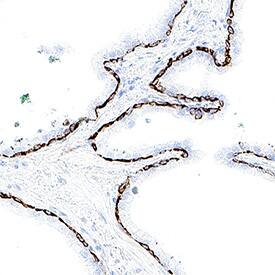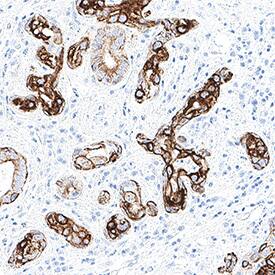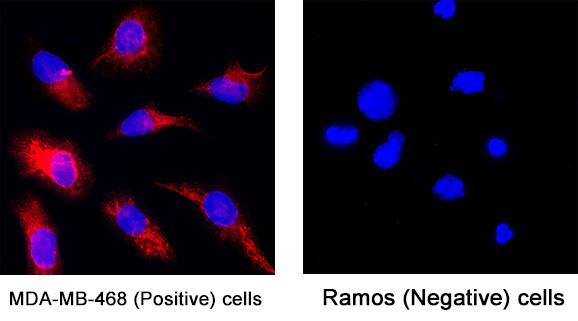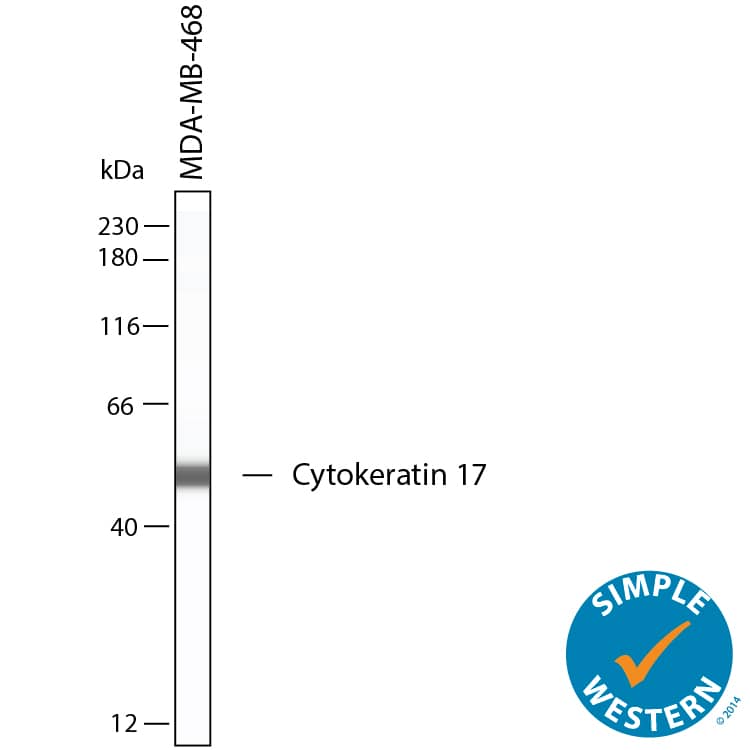Human Cytokeratin 17 Antibody
R&D Systems, part of Bio-Techne | Catalog # MAB11571

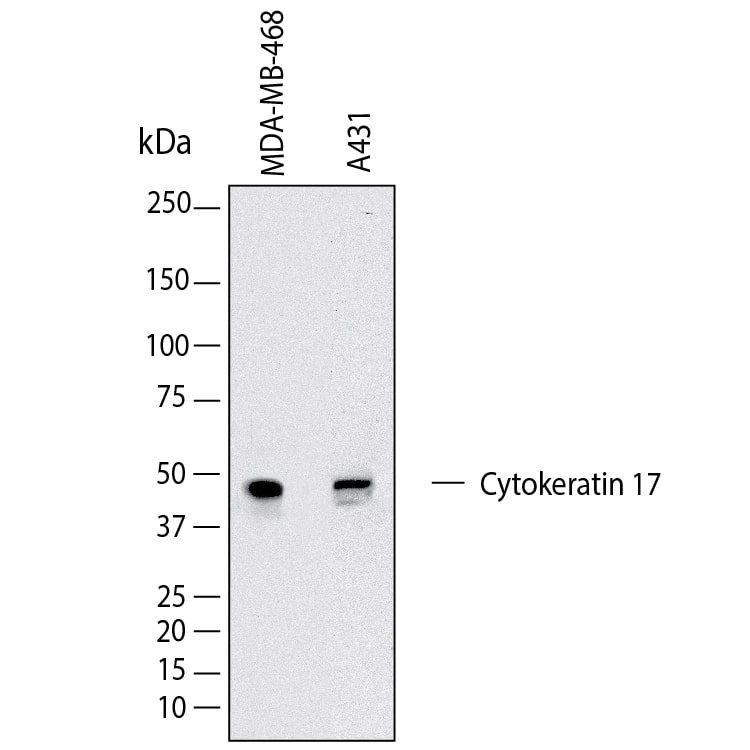
Conjugate
Catalog #
Key Product Details
Species Reactivity
Human
Applications
Immunocytochemistry, Immunohistochemistry, Simple Western, Western Blot
Label
Unconjugated
Antibody Source
Monoclonal Mouse IgG2B Clone # 1080235
Product Specifications
Immunogen
Cytokeratin 17 containing synthetic peptide
Accession # Q04695
Accession # Q04695
Specificity
Detects a synthetic peptide specific for Cytokeratin 17 around amino acid 120 in Direct ELISA.
Clonality
Monoclonal
Host
Mouse
Isotype
IgG2B
Scientific Data Images for Human Cytokeratin 17 Antibody
Detection of Human Cytokeratin 17 by Western Blot.
Western Blot shows lysates of MDA-MB-468 human breast cancer cell line and A431 human epithelial carcinoma cell line. PVDF membrane was probed with 2 µg/ml of Mouse Anti-Human Cytokeratin 17 Monoclonal Antibody (Catalog # MAB11571) followed by HRP-conjugated Anti-Mouse IgG Secondary Antibody (Catalog # HAF018). A specific band was detected for Cytokeratin 17 at approximately 53 kDa (as indicated). This experiment was conducted under reducing conditions and using Western Blot Buffer Group 1.Detection of Cytokeratin 17 in Human Prostate.
Cytokeratin 17 was detected in immersion fixed paraffin-embedded sections of human prostate using Mouse Anti-Human Cytokeratin 17 Monoclonal Antibody (Catalog # MAB11571) at 5 µg/ml for 1 hour at room temperature followed by incubation with the Anti-Mouse IgG VisUCyte™ HRP Polymer Antibody (Catalog # VC001) or the HRP-conjugated Anti-Mouse IgG Secondary Antibody (Catalog # HAF007). Before incubation with the primary antibody, tissue was subjected to heat-induced epitope retrieval using VisUCyte Antigen Retrieval Reagent-Basic (Catalog # VCTS021). Tissue was stained using DAB (brown) and counterstained with hematoxylin (blue). Specific staining was localized to the cytoplasm. View our protocol for Chromogenic IHC Staining of Paraffin-embedded Tissue Sections.Detection of Cytokeratin 17 in Human Squamous Cell Carcinoma.
Cytokeratin 17 was detected in immersion fixed paraffin-embedded sections of human squamous cell carcinoma using Mouse Anti-Human Cytokeratin 17 Monoclonal Antibody (Catalog # MAB11571) at 5 µg/ml for 1 hour at room temperature followed by incubation with the Anti-Mouse IgG VisUCyte™ HRP Polymer Antibody (Catalog # VC001) or the HRP-conjugated Anti-Mouse IgG Secondary Antibody (Catalog # HAF007). Before incubation with the primary antibody, tissue was subjected to heat-induced epitope retrieval using VisUCyte Antigen Retrieval Reagent-Basic (Catalog # VCTS021). Tissue was stained using DAB (brown) and counterstained with hematoxylin (blue). Specific staining was localized to the cytoplasm. View our protocol for Chromogenic IHC Staining of Paraffin-embedded Tissue Sections.Applications for Human Cytokeratin 17 Antibody
Application
Recommended Usage
Immunocytochemistry
3-25 µg/mL
Sample: fixed MDA-MB-468 human breast cancer cell line (Positive) and absent in Ramos human Burkitt's lymphoma cell line (Negative)
Sample: fixed MDA-MB-468 human breast cancer cell line (Positive) and absent in Ramos human Burkitt's lymphoma cell line (Negative)
Immunohistochemistry
3-25 µg/mL
Sample: Immersion fixed paraffin-embedded sections of human prostate and of human squamous cell carcinoma
Sample: Immersion fixed paraffin-embedded sections of human prostate and of human squamous cell carcinoma
Simple Western
100 µg/mL
Sample: MDA-MB-468 human breast cancer cell line
Sample: MDA-MB-468 human breast cancer cell line
Western Blot
2 µg/mL
Sample: MDA-MB-468 human breast cancer cell line and A431 human epithelial carcinoma cell line
Sample: MDA-MB-468 human breast cancer cell line and A431 human epithelial carcinoma cell line
Formulation, Preparation, and Storage
Purification
Protein A or G purified from hybridoma culture supernatant
Reconstitution
Reconstitute lyophilized material at 0.2mg/ml in sterile PBS. For liquid material, refer to CoA for concentration.
Formulation
Lyophilized from a 0.2 μm filtered solution in PBS with Trehalose.
Shipping
Lyophilized product is shipped at ambient temperature. Liquid small pack size (-SP) is shipped with polar packs. Upon receipt, store immediately at the temperature recommended below.
Stability & Storage
Use a manual defrost freezer and avoid repeated freeze-thaw cycles.
- 12 months from date of receipt, -20 to -70 °C as supplied.
- 1 month, 2 to 8 °C under sterile conditions after reconstitution.
- 6 months, -20 to -70 °C under sterile conditions after reconstitution.
Background: Cytokeratin 17
References
- Tang S, Liu W, Yong L, Liu D, Lin X, Huang Y, Wang H, Cai F. Reduced Expression of KRT17 Predicts Poor Prognosis in HER2high Breast Cancer. Biomolecules. 2022 Aug 25;12(9):1183. doi: 10.3390/biom12091183. PMID: 36139022; PMCID: PMC9496156.
- Hu H, Xu DH, Huang XX, Zhu CC, Xu J, Zhang ZZ, Zhao G. Keratin17 Promotes Tumor Growth and is Associated with Poor Prognosis in Gastric Cancer. J Cancer. 2018 Jan 1;9(2):346-357. doi: 10.7150/jca.19838. PMID: 29344281; PMCID: PMC5771342.
- Li D, Ni XF, Tang H, Zhang J, Zheng C, Lin J, Wang C, Sun L, Chen B. KRT17 Functions as a Tumor Promoter and Regulates Proliferation, Migration and Invasion in Pancreatic Cancer via mTOR/S6k1 Pathway. Cancer Manag Res. 2020 Mar 19;12:2087-2095. doi: 10.2147/CMAR.S243129. PMID: 32256116; PMCID: PMC7090205.
Long Name
Cytokeratin 17/KRT17
Alternate Names
CK-17, cytokeratin-17, K17, keratin 17, type I, keratin, type I cytoskeletal 17, PCHC1
Gene Symbol
Q04695
UniProt
Additional Cytokeratin 17 Products
Product Documents for Human Cytokeratin 17 Antibody
Product Specific Notices for Human Cytokeratin 17 Antibody
For research use only
